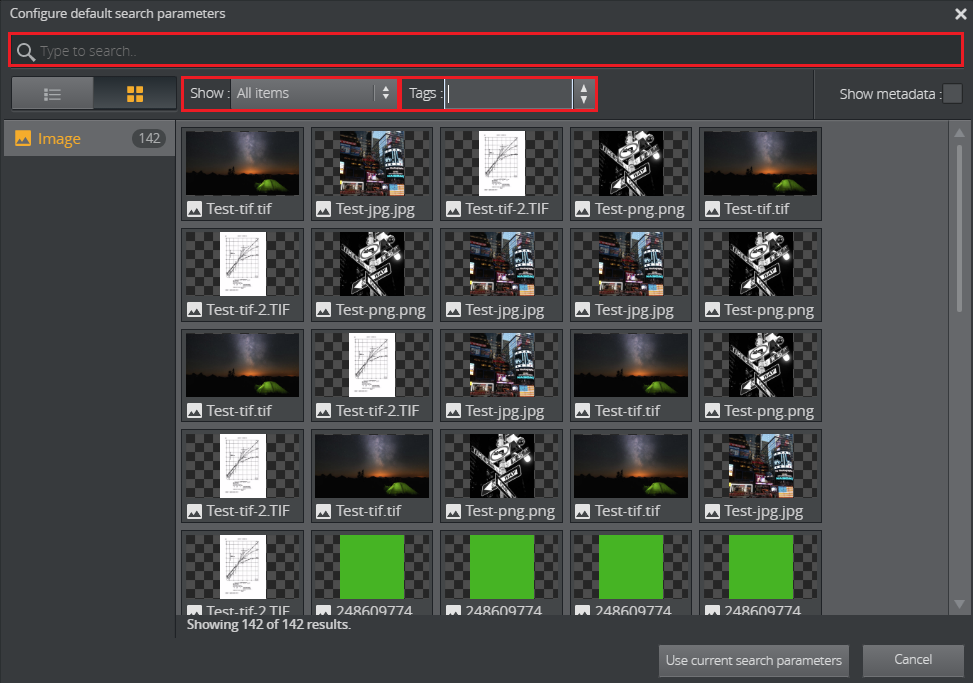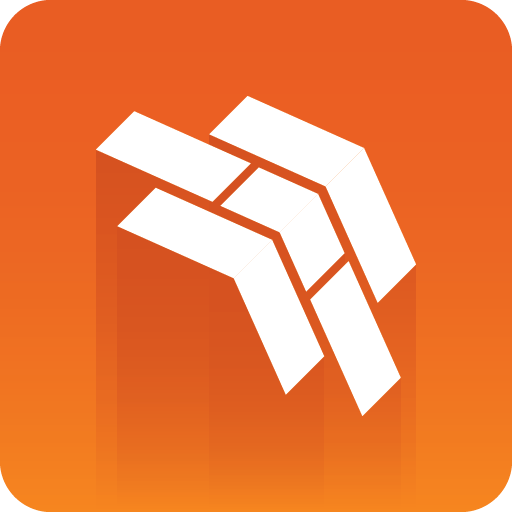
Template Builder User Guide
Version 1.1.1 | Published January 22, 2018 ©
The Template Builder Window
The Template Builder window is located to the left in the application and is where all the customization of the template is performed.
It consists of three windows:
Template Settings
At the top of the Template Builder Window a Settings drop-down list is available, which allows for the following template settings:
Duration
The duration setting can be used to specify the duration of the item. A default value is used when unspecified. Minimum and maximum duration values may also be specified. If these are set to the same number the item will get a fixed duration.

Track
Setting a Name in the track settings allows for grouping of graphics in the timeline editor, see Track settings displayed in the timeline editor. The Index sets the position of the group in the timeline editor, where 0 is the lowest position.
WARNING!
Make sure to use the same index for the same name in all modified templates

Track settings displayed in the timeline editor
The red rectangle highlights the different tracks in the timeline editor. The position of these tracks is set using the Track setting.

Title generation
The title generation setting allows for auto-generation of the title. The title can be plain text or it can be a placeholder for one or several field values, or it can be a combination. The placeholder is the {Field ID}. An example combining plain text, field name, and subfield name is shown below:

A template title can be auto-generated by combining one or several of these options:
-
Normal text - plain text
-
{Field ID} - will be substituted by the value of the field
-
{Field ID/subfield ID} - will be substituted by the value of the subfield
-
{listfieldname/#index/cellname} - will be substituted by the value of the field in a row in a list. Note that the index is zero-based.
WARNING!
The auto-generated title does not get trimmed inside Vizrt web clients. However, if the title is longer than 128 characters it will be trimmed when dragging out the MOS XML file due to size constraints. This will affect the element title in the newsroom system.
Field Tree
Each line in the Field Tree displays the ID and the label of a field and often corresponds to a field in the Fill In form. It also contains an icon indicating the Type of the field.
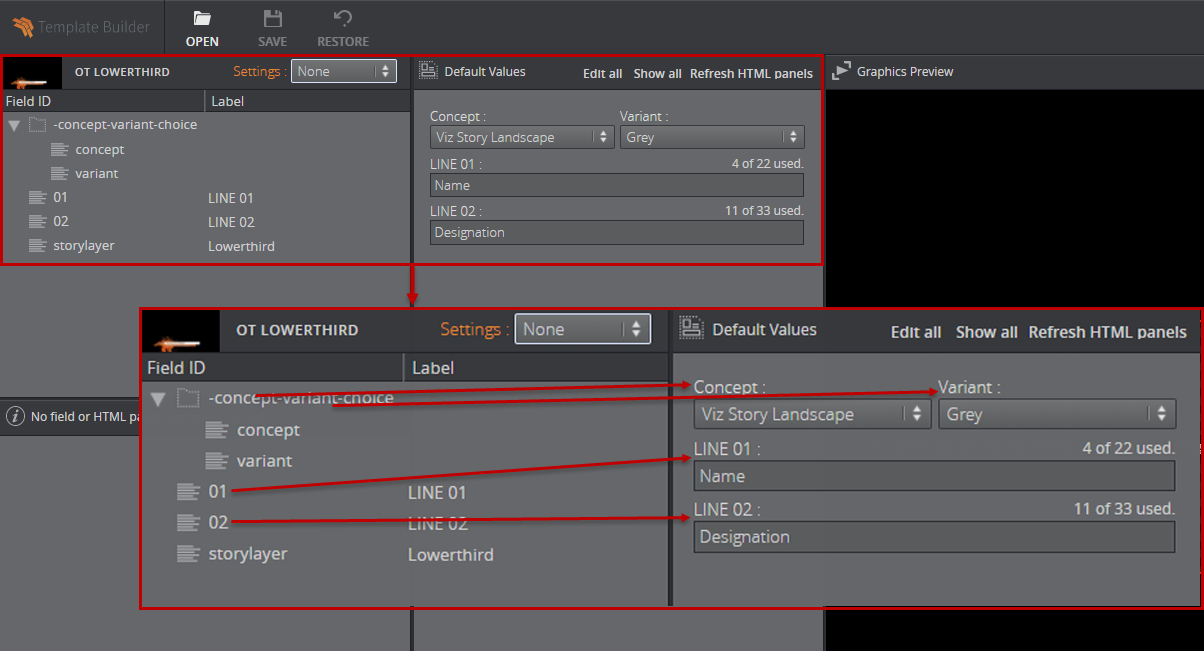
The listing of Fields can be rearranged by drag-and-drop within the Field tree.
Right-clicking a Field, a list of choices appears. From here Fields and HTML panels can be added.
The Fill In Form will always immediately update upon any change.
Info
Only Fields created in Template Builder can be deleted and given a new ID.
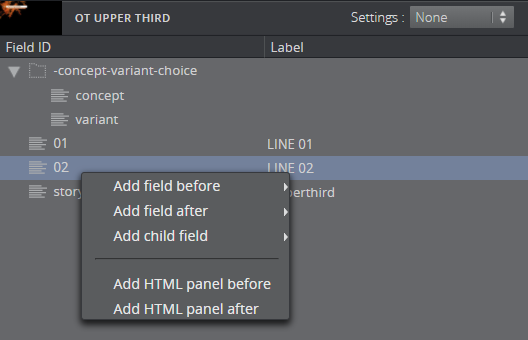
Multi-selection
It is possible to multi-select in the Field Tree. After selecting the first field of interest, more fields may be selected by CTRL + click. It is not possible to move or rename multiple fields at the same time, but multiple fields may be deleted and some of their properties may also be changed by making changes in the Field Properties window.
Field Properties
The Field Properties window is located below the Field Tree window. It displays the properties of the field(s) selected in the Field Tree.
-
Multi-selection - If several fields are selected in the Field Tree, a subset of the field properties for the selected fields are displayed. If the selected fields have different field property values, the Field Properties window displays a multiple values state. Changes made in the Field Properties window are immediately applied to all the selected fields.
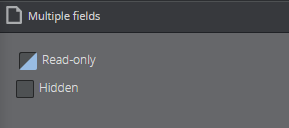
-
Single-selection - All properties for the selected field are displayed. Note that the set of properties depend on the type of the field.

Label
Specifies the label of the field in the Fill In Form.
Tip text
A tooltip text can be entered to give more information about the field.
Read-only
Selecting the Read-only checkbox will keep the field visible, but grayed out in the Fill In Form.
Hidden
Selecting the Hidden checkbox will hide the field in the Fill In Form.
Type
The type of content allowed in the field in the Fill In Form are set using the drop-down list under Type. Depending on the type selected different sub-choices become available which is specified in the table below.
There are two main field type categories, scalar and list. Fields with all types except the list type are referred to as scalar fields. Fields using the list type are referred to as list fields.
The following types are available:
|
Type |
Icon |
Description |
|
Empty |
|
Will make the field unavailable. Typically used as a container for other fields. |
|
Plain text |
|
The field is a text field. Max length: Set the number of maximum characters in the field. |
|
Normalized text |
|
Normalized text. Max length: Set the number of maximum characters in the field. |
|
Formatted text |
|
A text that allows formatting. Max length: Set the number of maximum characters in the field. Single-line: Check this box to specify that the rich-text editor should only allow one line of text. |
|
Boolean |
|
Creates a checkbox which have two states; true and false. |
|
Integer |
|
The field is an integer field. Minimum: Set the minimum value allowed. Maximum: Set the maximum value allowed. |
|
Decimal |
|
The field allows decimal numbers. Minimum: Set the minimum value allowed. Maximum: Set the maximum value allowed. |
|
Date and time |
|
Use the Date Chooser in the Fill In Form to select date and time in this field. |
|
Two numbers (duplet) |
|
The field allows two numbers (decimal numbers are allowed). Minimum: Set the minimum value allowed for both numbers. Maximum: Set the maximum value allowed for both numbers. |
|
Three numbers (triplet) |
|
The field allows three numbers (decimal numbers are allowed). Minimum: Set the minimum value allowed for all three numbers. Maximum: Set the maximum value allowed for all three numbers. |
|
Image |
|
Will make the field available for an image. |
|
Video |
|
Will make the field available for a video. |
|
Font |
|
Will make the field available for a font. |
|
Geometry |
|
Will make the field available for a geometry. |
|
Material |
|
Will make the field available for a material. |
|
Map |
|
Will make the field available to present and edit a map. |
|
Custom |
|
Using the custom type the media- and XSD- type can be freely specified. |
|
List |
|
Lists may be modified by adding and removing columns in the Field Tree. To add columns to a list, right-click the columns node under the list field node in the Field Tree and select Add column. To remove a column, select the column field in the Field Tree and press the Delete button, or right-click it and select Delete field. List fields are fundamentally different from scalar fields. It is therefore not possible to change a list type to a scalar type and vice versa. Minimum number of rows: This field property defines the minimum allowed number of rows in the list. Maximum number of rows: This field property defines the maximum allowed number of rows in the list. |
Note:
The user must be aware of available control plugins in the template that have been exposed by the scene designer in Viz Artist.
Data Entry
There is a Data entry drop-down list available for all scalar field types. There are three choices in this drop-down list, namely Manual, Choose from list and Enable feed browser.
Manual does not open up to any additional settings for the field.
Choose from list allows the template designer to present the right content in a drop-down list.
Enable feed browser allows the user to browse for an entry.
Default search parameters
For the types Image, Video, Font, Geometry, and Material it is possible to define default search parameters that will be used by the media search that is launched when the user clicks on the field.
To define the search parameters for a field, click the Set button to open a media search window.
Set the search parameters by writing something in the search field, selecting whether to show all items or to limit by time from the Show drop-down list, and/or selecting a tag from the Tags drop-down.
Save by clicking Use current search parameters.
